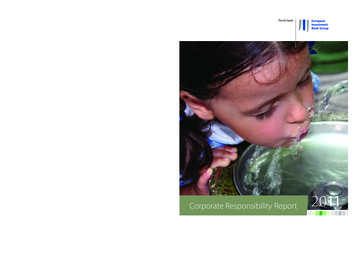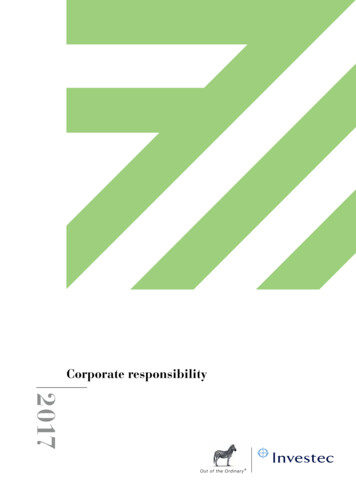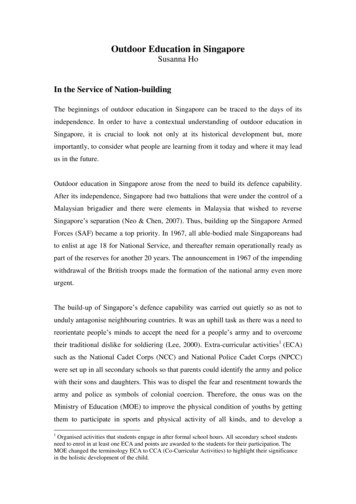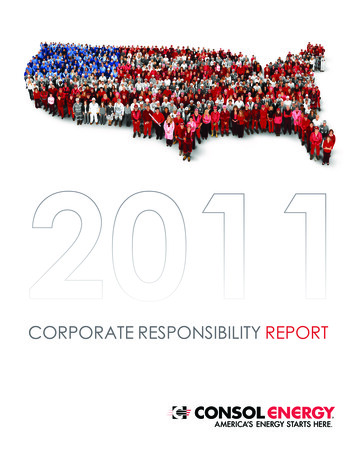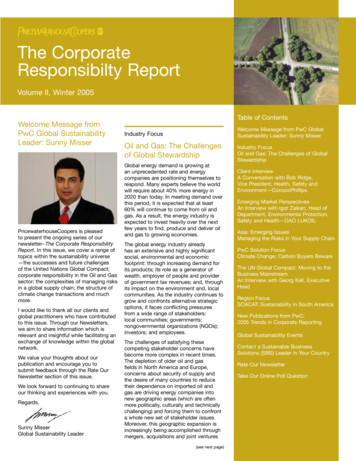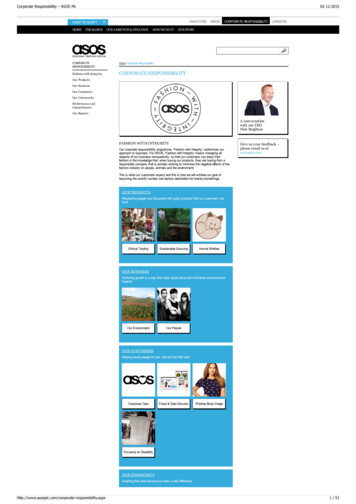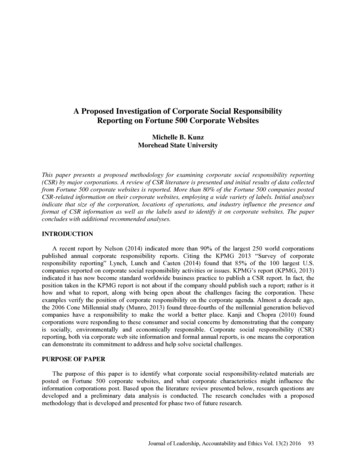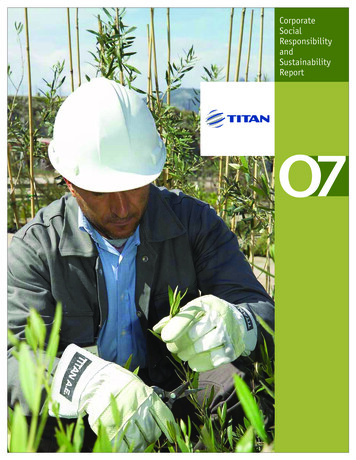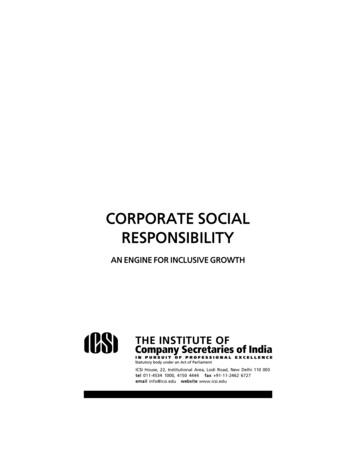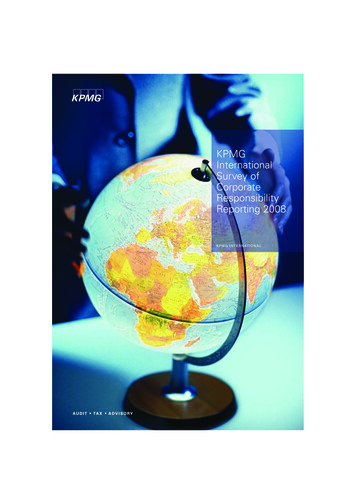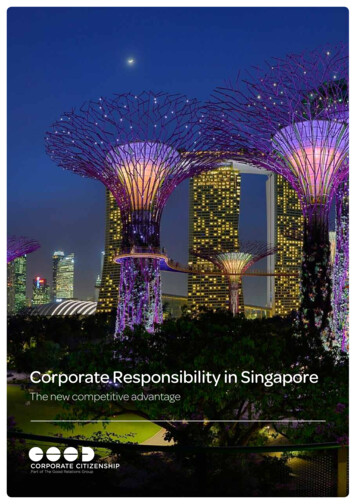
Transcription
Corporate Responsibility in SingaporeThe new competitive advantageCorporate Responsibility in Singapore – The new competitive advantage October 2013 Corporate CitizenshipPage 1
Page 2 Corporate Citizenship October 2013 Corporate Responsibility in Singapore – The new competitive advantage
ContentsIntroduction.2The Asian Century.3The Competitive Advantage Approach.4The Singapore Study.6A Guide to Managing Corporate Responsibility for Competitive Advantage.8Where Next for Corporate Responsibility?.9References.9Corporate Responsibility in Singapore – The new competitive advantage October 2013 Corporate CitizenshipPage 1
IntroductionMany companies in Asia have a long history of playingan active role in society. Philanthropic donations area common way of giving back to communities. Manybusinesses have employee volunteering programmesand environmental initiatives such as energy savingand recycling.Pioneering businesses aretaking the bold step of linkingcorporate responsibility tocompetitive advantage.Today we are witnessing a seismic shift in whatresponsible business practices mean in countries aroundthe world, including Singapore. Pioneering businesses aretaking the bold step of linking corporate responsibility (CR)to competitive advantage. They are managing their social,environmental and economic impacts to create value fordifferent stakeholders in society. We are also detectingincreasing evidence that well-managed CR programmescan create real value for businesses too.Our study reveals that half of the largest companiesin Singapore link CR to competitive advantage. Theyarticulate how CR helps to manage risks, build resilience,realise financial savings, and provide a springboard forinnovation. We compare this emerging trend with globalbest practice, drawing on our experience of working withleading companies around the world over the last 15years.Different companies use words such as “sustainability”,“CSR” and “shared value”. We use the term corporateresponsibility to refer to how organisations voluntarilymanage environmental, social and economic issues toreduce their negative effects and maximise their positiveimpacts.Responsibly-run companies provide a wealth of benefitsto society. We suggest that the future of CR in countrieslike Singapore may lie in benefits to the business beingbuilt-in. This powerful win-win combination provides theopportunity to make a long-term commitment to createa positive impact. We outline the four steps that anybusiness can take to realise the maximum value from aCR strategy today.The benefits of CR include stronger relationshipswith key stakeholders and enhanced reputations withcustomers for many companies. But some elaborate ona wider range of opportunities.Page 2 Corporate Citizenship October 2013 Corporate Responsibility in Singapore – The new competitive advantage
The Asian CenturyAsia could account for half of the world’s output andhave an additional 3 billion people with high livingstandards by the middle of this “Asian Century”,according to the Asian Development Bank.1If this dream is realised, the growth in the size and powerof many companies in the region will be profound. Moststakeholders accept that businesses have a key role toplay in solving some of the big issues facing the region.Climate change, poverty, governance, product safety,human rights and corruption have been cited as someof the most significant topics for companies in Asia toaddress.2Asia is a hugely diverse region and CR practices varydramatically from country to country, as well as betweenbusinesses. In this paper, we focus on the experience ofSingapore – often regarded as the crossroads of EastWest trade and a melting pot of cultures - to shed lighton the shape of CR in the region today.Previous research suggests that CR in Singapore ischaracterised by a central role for government, but incollaboration with unions and employers. It has alsobeen suggested that CR has a “somewhat ambivalent, ifnot patchy, presence in Singapore”.3This could be changing. The institutional drivers havebeen shifting and creating new pressures on businessesto respond. Philanthropy has traditionally been acentral part of CR, particularly for many family-ownedbusinesses. But new approaches have emerged inrecent years that make it timely for a study to compareSingapore’s experience with global benchmarks.With any fast-growing economy, expectations ofglobal standards in products and services often rise,accompanied by an increased desire and ability tochallenge and expect more from businesses. Thispresents multiple opportunities for companies, but alsoclear risks if firms do not keep up with expectations.Governments and other institutions are promotingCR through a variety of guidelines and mechanisms. Abarrage of different environmental and social standards,platforms and indices are emerging. The Dow JonesSustainability Index launched an Asia Pacific Index in2009. This now includes around 20% of the top 600companies in developed Asia Pacific markets.4 InSingapore, incentives such as the Green Mark Schemefor the construction industry, or Grant for EnergyEfficient Technologies (GREET), serve to bring aboutgreater CR efforts from businesses.The booming number of CR and sustainability reports isanother clear indicator of the development of the field.According to a recent study, the number of companiesproducing CR reports in Singapore jumped 77% in 2012.5Increasingly, Singaporean companies are undertakingreporting based on best practice guidance such as theGlobal Reporting Initiative (GRI).All these trends point towards CR playing a moresignificant role in the internal processes of Singaporeanbusinesses. But with any change, there are also newchallenges. From our experience of helping companiesapproach these issues strategically, we are often askedthe same questions:1. Which are the most important stakeholderconcerns for my business to address?2. How do we identify our biggest business impacts –both negative and positive?3. Where should we focus attention and what metricsshould we set?4. How is it best to communicate and explain what weare doing?Some of the world’s most successful companies areanswering these questions through viewing CR as a driverof competitive advantage.Corporate Responsibility in Singapore – The new competitive advantage October 2013 Corporate CitizenshipPage 3
The CompetitiveAdvantage ApproachCorporate Citizenship’s CompetitiveAdvantage approach sets out to simplifythings. We explain the four key areas that anybusiness can focus on in order to realise thecommercial benefits of CR.We like to think of CR as a bit like a ship: thereare the visible benefits ‘above the surface’that can be shown to the outside world. Butthe hidden value lies beneath the surface.2FINANCIAL SAVINGSare the monetarybenefits from reducinginefficiencies, tackling wasteand minimising hazards. Cuttingenergy and greenhouse gasemissions, improving workersafety and reducing waste inproduction can improve thebottom line. Sometimes thesebenefits can be realised quickly,but often the payback periodscan take years.EXAMPLES:Chinese electronics factoriesthat invest in responsibleworker conditions can improveproductivity, raise profit marginsPage 41REPUTATION ANDRELATIONSHIPS arethe visible effects of CRprogrammes that lie above thesurface. Companies are engagingwith key audiences as part ofa dialogue on CR, producingreports, winning awards, andcommunicating CR initiativesto customers. Employees arealso a key audience for manycompanies: effective CR can helpto attract, motivate and retain thebest employees.and reduce employee turnover– with a payback period of 4-20months, according to a study byKPMG.9CapitaLand announced inJuly 2013 that operationalefficiencies through energy andwater reduction had providedcost avoidance in excess of S 35million for utilities since 2009.10City Developments expects tosave 712,000 per year afterinstalling infrastructure upgradesat one of Singapore’s largestskyscrapers. The companyanticipates a payback period offive years or less.11There are many examples ofcompanies in Asia using CRto enhance their reputation.Our research indicates thatthis is by far the most popular‘business benefit’ for corporateresponsibility today (see: page 6,The Singapore Study).EXAMPLES:Singapore Airlines, OCBC Bankand DBS Bank support a numberof community initiatives throughhigh-profile sponsorships as part3RISKS AND RESILIENCErefers to how businessesminimise vulnerabilitiesand anticipate upcoming issues.For example, because Asia isparticularly exposed to naturaldisasters,12 understanding thedynamics of the supply chain canmake companies more resilient toshocks and disruptions. Engagingwith governments and not-forprofits can help to prepare forupcoming regulations (perhapsahead of competitors) or respondto campaigns that risk harmingreputation.EXAMPLES:Golden Agri-Resources usesstakeholder engagement to identifyand respond to new issues fromgovernments, customers, not-forprofits and local communities.13 Corporate Citizenship October 2013 Corporate Responsibility in Singapore – The new competitive advantage
of their CR programmes. Theseprovide the opportunity for theirbrand to be associated with theircommunity efforts.6Standard Chartered soughtto restore trust following thefinancial crisis among clients inthe region through launchinga “new brand promise” called“Here for good” that promotes itsrole in the community throughan advertising campaign.7It has an excellent track record ofworking with the Forest Trust inaddressing palm oil production issuesof concern to international customers.Furthermore, in June 2013, whenSingapore, Malaysia and Indonesia sawhaze pollution reach hazardous levels,Golden Agri-Resources respondedquickly to say that they were “workingvery closely with the Indonesiangovernment and all relevant partiessuch as civil society organisations,local communities and other growersto put out the fires”.14HSBC has developed a series of riskpolicies for investment in sensitivesectors such as defence, mining andforest products. Customers of thebank are monitored for compliancelevels as part of a programme toreduce sustainability risks that arefaced around the world.15Starhub, Singapore’s localtelecom , recently entered intothe global rankings of the Top 100Most Sustainable Corporations.Starhub has made a public pledgeto ‘Go Green’ in the long haul. Thisfollows a 6-Point CommitmentPolicy made in 2009 – regardedas a formalisation of itscommitment.84INNOVATIVE INSIGHTSare the benefits thataccrue from developingnew processes, business models,products and services through thelens of corporate responsibility.For example, some companiesare sourcing raw materials ordistributing products in ways thatenhance worker livelihoods. Otherssell products that provide safedrinking water, affordable housingor low-cost renewable energy.These bring tangible benefitsto society as well as financialbenefits to the business. Innovativeinsights can be the hardest forthe company to spot, but theyprovide the most transformationalopportunities and genuineevidence for a strong and trustedbrand in the long-term.The deeper, ‘below the surface’ benefits aremore strategic. They are harder to measurebut provide the depth and stability for thecompany and ensure a smooth ride in thelong-term. The Competitive Advantageapproach identifies four areas to realise thevalue for both the business and society fromcorporate responsibility.EXAMPLES:SingTel, Southeast Asia’s largesttelco company, has set targets aspart of its sustainability programmeto engage with its customersthrough social media and pioneerbetter e-services. The companylaunched a suite of ICT solutions inNovember 2012 to help corporatecustomers and governments to“improve productivity and lowertheir operating costs effectively.” 16Unilever has recruited and traineda network of women entrepreneursin poor, rural areas of India,Bangladesh, Sri Lanka and Vietnam.They have expanded the consumergoods company’s sales whilstdoubling the household incomes ofthe ‘Shakti’ entrepreneurs.17Corporate Responsibility in Singapore – The new competitive advantage October 2013 Corporate CitizenshipPage 5
The Singapore StudyWe undertook a detailed review of the 20 largestcompanies in Singapore (according to the Forbes Global2000 list). The aim was to understand their currentstrategies, targets and reporting on CR – and comparethis to a global benchmark.The scope of CR and the targets set varied quitemarkedly. All of the companies included some social orcommunity aspects in their CR programme. This includedinitiatives on health and safety, HR, labour rights andcommunity partnerships.Critics may allege that anabsence of targets meansCR is not a priority for thecompany.Proportion Setting Targets5040Proportion Mentioning10090100%% ntEconomic95% also mentioned the environment, coveringeverything from small-scale recycling initiatives throughto strategic plans to develop low carbon fuels.But the economic component noticeably lagged behind theother dimensions of sustainability. 60% mentioned activitiessuch as job creation, enhancing livelihoods or supporting theeconomy in other ways. Others, such as SingTel, identifiedsustainable business growth and new market opportunitiesas the economic component of their strategies.Compared with global best practice, the analysis suggestsSingaporean businesses are less likely to have publishedmeasurable goals for their CR programmes. The risk ofthis approach is that critics may allege that an absence oftargets means that CR is not a priority for the company. Bymaking a public commitment to targets, companies canshow that their commitment to CR is for the long-term.One potential solution will be for companies to settargets on CR issues that are intended to drive businessperformance as well as social outcomes. Companies thatundertake a systematic approach to impact assessmentoften find that the greatest benefits the business brings tosociety are in the economic sphere. There are a numberof different approaches to understanding this impact, buta credible system of metrics can help with effective targetsetting. By overlooking the positive economic impactsof the business – in areas such as job creation, salaries,local procurement and tax contributions - businesses inSingapore are potentially underrepresenting the role thatthey play.Target SettingThe setting of targets was much less widespread. Welooked for whether there were any published quantitative orqualitative targets in each of the three areas. The majorityof large firms had set no targets. One in three had setenvironmental targets. Social and economic targets were onlyevident in one in five of all the companies in the sample.Conversely, global best practice companies publishrobust targets so that stakeholders can hold them toaccount. For example, Walmart reports against 42short, medium and long-term metrics in its 2013 GlobalResponsibility Report.Page 6By overlooking the positiveeconomic impacts of thebusiness, businesses in Singaporeare potentially underrepresentingthe role that they play.Commercial AdvantageWhilst many companies focus on communityinvolvement and environmental initiatives, some have Corporate Citizenship October 2013 Corporate Responsibility in Singapore – The new competitive advantage
begun to link CR to the commercial goals of the firm andarticulate how it is contributing to business success.For example, 35% of large Singaporean companiesincluded an aspect of their CR as part of the commercialstrategy of the business. For example, KeppelCorporation has a mission statement to “execute ourbusiness profitably, with Safety and Innovation, guidedby our three key business thrusts of Sustaining Growth,Empowering Lives and Nurturing Communities.”We used Corporate Citizenship’s Commercial Advantageframework (see pages 4-5) to identify which potentialbenefits were stated as motivators for Singaporeancompanies’ CR programmes.Commercial Advantage Cited10090807050% vingsRisk &resilienceReputation &relationshipsEngagementStakeholder engagement is a popular way for companiesto understand what different organisations expectthem to address and report on. Just under half of thecompanies (45%) referred to engagement in someform. But only 30% of the companies explained how thisengagement had shaped their programme or reporting,such as through a materiality matrix.This indicates that the real value of engagement is not alwaysbeing realised and communicated back to stakeholderswho may have given input. For example, from the globalbenchmark, Royal Dutch Shell presents a materiality matrixin their reporting, illustrating the role of stakeholders inprioritising issues and shaping their reporting.Just under half ofSingaporean companieshave produced a separate,stand-alone CR report in thelast 2 years.ReportingThe vast majority (85%) provided evidence thatreputation and relationships are a reason for doing CR.This includes prominent sponsorships, winning awardsand building relationships with employees throughactivities such as volunteering.In total, half of the companies cited evidence that CRwas intended to create some other type of commercialadvantage. The most popular was risk and resilience:30% mentioned that this was a significant component ofCR, meaning that it was either expressed as an objectiveor a benefit from the programmes.Fewer mentioned financial savings or developinginnovative insights such as products and services thatmeet social needs.Some global companies provide evidence of a wider rangeof commercial advantages. For example, General Electrichas reported that its ‘Ecomagination’ line of sustainableproducts has resulted in revenues of over 105 billionsince its launch.18It is notable that companies in Singapore place emphasison different areas of competitive advantage, but thereappears to be variation between sectors. For example,cost savings can be easier to calculate in manufacturingand property, whilst risk is a more pressing priority foragricultural companies. It is likely that further examples ofcompetitive advantage could emerge in the coming yearsas the evidence for linking CR to commercial successbecomes more widespread.Unsurprisingly, integrated reporting is very popularamongst the largest companies in Singapore due to theguidance for listed firms. 95% dedicated a substantivesection of their most recent annual report to CR (100% oflisted firms). But there is a large degree of variation in howCR is integrated into financial reporting.Conversely, just under half of the Singaporean companies(45%) have produced a separate, stand-alone CR report inthe last 2 years.This is in sharp contrast to the global benchmark. Wefound that 65% of the largest 20 companies in theworld undertake some form of integrated reporting.19However, a full 85% produce a stand-alone report including Volkswagen, Apple, JP Morgan, Citi, HSBC, BP,Samsung and PetroChina.This means that large global companies are twice aslikely as Singaporean ones to produce a CR report thatprovides detailed information to specialist audiences. Itillustrates how, perhaps as a result of the push towardsintegrated reporting, many companies in Singapore havenot yet capitalised on the opportunity to report on CR toaudiences other than investors.Singaporean companies are also slightly less likely toengage in major global initiatives. We found that 35% weresignatories to the UN Global Compact (compared to 40%of global benchmark) and 20% are listed in the Dow JonesSustainability Yearbook 2013 (compared to 25% globally).Corporate Responsibility in Singapore – The new competitive advantage October 2013 Corporate CitizenshipPage 7
A Guide to Managing CR forCompetitive AdvantageWhether just starting out or ready to make a step-change to the next level, we advisecompanies to follow a four-step process to capture the most value for business andsociety from CR:1234Page 8Know your stakeholders and understand their issues. Stakeholder engagement should identifywhat the expectations are of the business today as well as spot upcoming risks and opportunities.Representatives of governments, employees, not-for-profits and customers can provide valuablecontributions to shape CR programmes and reporting. Many companies find that an independentassessment of their most recent CR report can provide crucial insights into potential gaps as well asfresh ideas for new focus areas.Assess your impacts. What are the most significant risks and opportunities from the perspectiveof the business? How do you create value for society? Understanding the most important social,environmental and economic impacts can help to answer these questions. Corporate Citizenship’saudit tool and impact assessment frameworks are designed to deliver tangible outcomes and helpfocus attention on where it matters. This can also help to prioritise investments to make the mosteffective business case for a strategy.Develop a strategy. A strategic approach to CR means prioritising the external and internal issuesas part of a materiality assessment. Effective strategies are driven by business priorities, focus onmaterial issues and are aligned with external expectations. Performance indicators should be set todrive progress forward. An implementation plan makes a strategy more than just a piece of paper – itgives a roadmap to improve performance, monitor the right metrics and enhance company impacts.Communicate and engage. Regular reporting in a transparent manner is crucial to buildingtrust, enhancing reputation and explaining to stakeholders how CR benefits society and is a realcommitment of the business. Engaging the right audiences – whether corporate stakeholders,employees, shareholders or government – can be enhanced through credible reporting andindependent assurance. Corporate Citizenship has reviewed and assured hundreds of reports forleading companies and provides detailed recommendations on how to improve the effectiveness ofCR programmes. Corporate Citizenship October 2013 Corporate Responsibility in Singapore – The new competitive advantage
Where Next for CorporateResponsibility?Corporate responsibility in South-East Asia is undergoing aperiod of dynamic evolution. Ambitious companies want tobe global players. That means global standards in all aspectsof their business operations, whilst remaining true to theirheritage and unique culture. By understanding global CRstandards and best practice, businesses can ensure thatthey act as global citizens. It means their programmes cancreate the most value for everyone involved.The future of corporate responsibility will also involvethe world learning from Asia. Companies in the region willbring their own experiences to the global stage of how tomarry a responsibility to society with the opportunities ofcommerce. Companies in Asia often have a particularlynuanced understanding of how to build strongstakeholder relations. Asian values such as reciprocity,harmony with nature and respect for others are highlyrelevant cultural frameworks for sustainability.For Singapore, the lessons learnt from integrated reportingcan no doubt provide a wealth of knowledge for othercompanies now grappling with these challenges. Asthe world’s centre of gravity shifts east, a massive andpowerful new audience of consumers will have their ownviews on the responsibilities of companies. So the futureflows of knowledge will be two-way and we should allconsider the role that we can play in sharing those insights.In the long-term, the big issues facing the region likeclimate change, income inequality and communitycohesion can only be tackled effectively if companies arepart of the solution. Globally, the role of wealth creationand distribution is becoming increasingly shared betweengovernments, businesses and other civic organisations.Companies are here to stay and so the onus is onbusinesses to demonstrate the value that they bring tosociety.The future of corporateresponsibility will also involvethe world learning fromAsia . Asian values such asreciprocity, harmony withnature and respect for othersare highly relevant culturalframeworks for sustainability.Commerce can be a powerful force for change:providing jobs, new skills and investment. Usefulproducts and services can create real social value. Forthe companies powering the Asian century, successlies in demonstrating that they meet society’s needsin a way that creates value for all. By demonstrating acommitment to responsible business, they can providethe strongest foundations for the rest of the world toadmire their contribution.References1Asia 2050—Realizing the Asian Century, Asian Development Bank, May 201112ADB Response to Natural Disasters, Asian Development Bank, October 2012CSR in Asia: The Real Picture LRQA and CSR Asia, 201013Sustainability Report 2011, Golden Agri-Resources2The State of Play of CSR In Singapore, Eugene K B Tan, Lien Centre for SocialInnovation, July 201134Dow Jones Sustainability Asia/Pacific Index Guide, 4 April 2013Business Times (Singapore), citing Paia Consulting, 1 August 2013. Study wasbased upon those reporting against the GRI framework.5Information taken from the relevant section of corporate websites, accessedduring July and August 2013.67Investing in Sustainability for the Long Haul, Eco-business.com, 19 August 20138Standard Chartered positions brand to support sustained growth in the world’sfastest-growing economies, Standard Chartered Press Release, 31 March 20109Business Case Analysis for Responsible Electronics Manufacturing, IDH, Infact,KPMG, March 201310Capita Land’s Fourth Global Sustainability Report reflects progress in reportingon its global performance, Capita Land Press Release, 31 July 2013RSPO to use digital maps to establish where fires are burning, TodayOnline, 25June 201314Sustainability Risk, lity-riskaccessed 2 September 20131516Sustainability Report 2012: Connecting People, Touching Lives, SingTel, June 201217Sustainable Living Plan Progress Report 2012, Unilever, April 2013‘We Are Only Getting Started’: GE’s ecomagination Tops 100 Billion inRevenues, GE Press Notice, 28 June 20121819Despite attempts to standardise approaches, integrated reporting meansdifferent things to companies around the world. For this study, we countedthe number of businesses that made a substantive attempt to report on theircorporate responsibility programmes in their main annual report to shareholders.This needed to be more than a passing reference but it does not mean that nonfinancial metrics were always presented.Skyscraper Saves 712,000 Annually From Retrofit, Environmental Leader, 4December 201211Corporate Responsibility in Singapore – The new competitive advantage October 2013 Corporate CitizenshipPage 9
About Corporate CitizenshipCorporate Citizenship is one of the longest standingspecialist sustainability consultancies, working withcorporations around the world to achieve theircommitments to being responsible businesses,built on sustainable practices.Founded in 1997, we’re proud to be working with ahuge variety of companies, large and small. Our highlySingapore Office:c/o StratAgile Pte Ltd10 Anson Road #39-07International PlazaSingapore 079903T: 65 6836 9098E: mail@corporate-citizenship.comW: www.corporate-citizenship.comexperienced 35-strong team bring practical andpragmatic solutions to often complex challenges.Faced with the big issues confronting the world today,we passionately believe that companies are part ofthe solution, and we help make it happen. CorporateCitizenship is part of The Good Relations Group, ownedby Chime Communications Plc and listed on the LondonStock Exchange (CHW.L).UK office:5th FloorHolborn Gate26 Southampton BuildingsLondon WC2A 1PQT: 44(0)20 7861 1616US office:241 Centre Street4th FloorNew YorkNY 10013T: 1-212-226-3702DISCLAIMER:Every possible effort has been made to ensure that the information contained in this publication is accurate at the time of going to press, andthe publishers and author cannot accept responsibility for any errors or omissions, however caused. No responsibility for loss or damage occasioned to anyperson acting, or refraining from action, as a result of the material in this publication can be accepted by the editor, the publisher or author.Corporate Responsibility in Singapore – The new competitive advantage October 2013 Corporate CitizenshipPage 10
corporate responsibility to competitive advantage. Today we are witnessing a seismic shift in what responsible business practices mean in countries around the world, including Singapore. Pioneering businesses are taking the bold step of linking corporate responsibility (CR)
